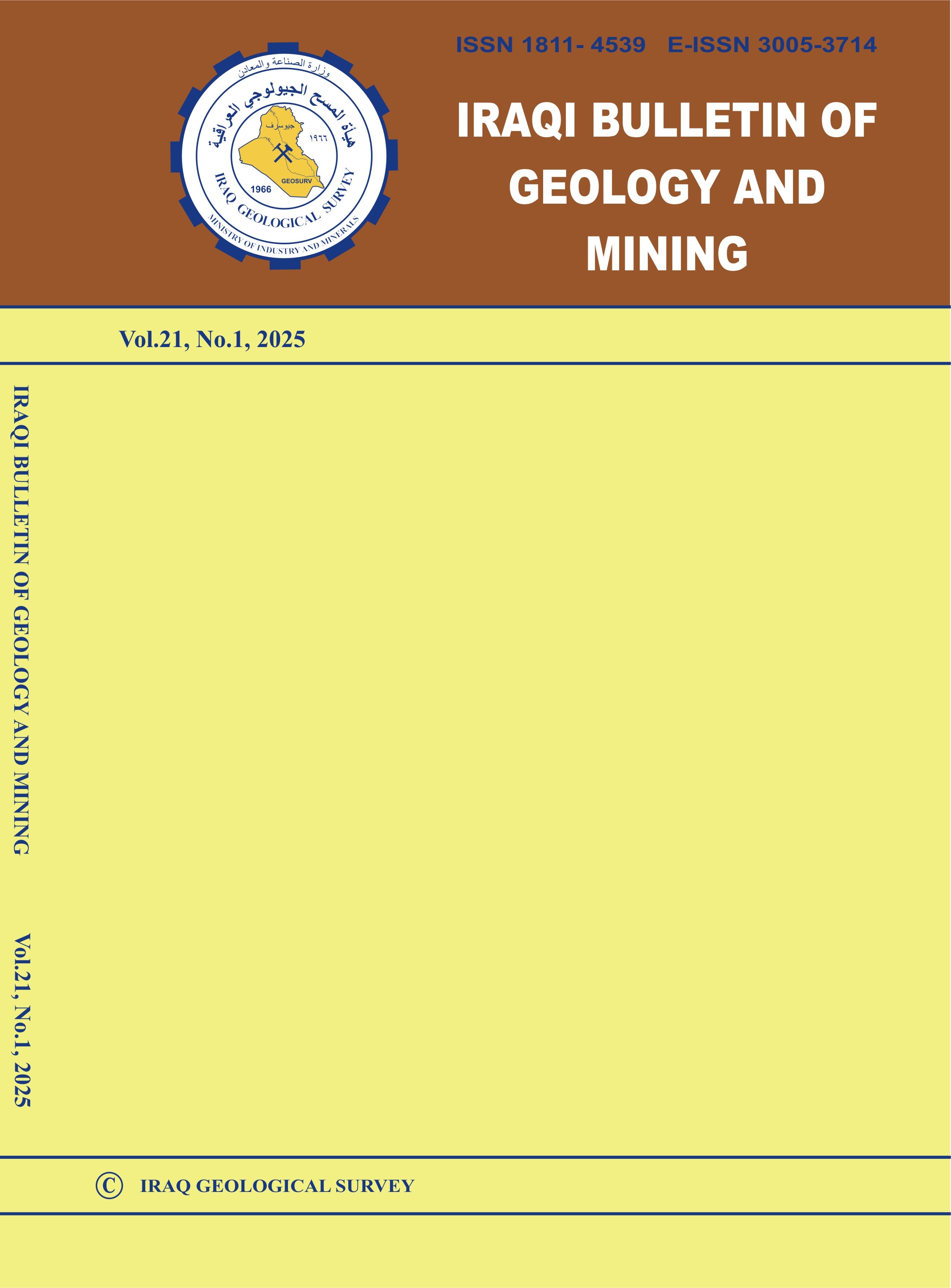Abstract
Al-Salman Depression is one of the largest karst forms in the Southern Desert of Iraq. It is of doline type, being formed in carbonates of Dammam Formation of Eocene age. The length of the depression is 20 Km, whereas, the width is variable, it is (6.5, 10 and 4.5) Km, in the northern, central and southern parts, respectively, whereas, the depth ranges from (5 – 35) m.
The Iraqi Southern Desert is one of the most extensive karstified areas in Iraq. Different types and forms of karst were developed with different sizes. Among the karst forms is Al-Salman Depression. The main reason of karstification is the presence of the carbonates of the Dammam Formation, which are underlain by the Rus Formation (Early Eocene); it consists mainly of anhydrite with limestone interlayers.
The Pleistocene Period witnessed wet climate in the studied area, which had contributed in the karstification of the Iraqi Southern Desert, in which karst forms have played a big role in development of special landscape, which is characterized by special drainage system and enormous amount of closed depressions and blind valleys. Originally, Al-Salman Depression was consisting of three main depressions, which merged together due to karstification, head ward erosion and collapsing parts of the rims. The presence of the sediments of Zahra Formation (Pliocene – Pleistocene) in the Salman Depression indicates Pliocene and most probably uppermost Late Miocene age for the depression that has developed due to karstification and collapsing, which are still active processes. This age and genesis hold good for all those large depressions in the Iraqi Southern Desert.
The Iraqi Southern Desert is one of the most extensive karstified areas in Iraq. Different types and forms of karst were developed with different sizes. Among the karst forms is Al-Salman Depression. The main reason of karstification is the presence of the carbonates of the Dammam Formation, which are underlain by the Rus Formation (Early Eocene); it consists mainly of anhydrite with limestone interlayers.
The Pleistocene Period witnessed wet climate in the studied area, which had contributed in the karstification of the Iraqi Southern Desert, in which karst forms have played a big role in development of special landscape, which is characterized by special drainage system and enormous amount of closed depressions and blind valleys. Originally, Al-Salman Depression was consisting of three main depressions, which merged together due to karstification, head ward erosion and collapsing parts of the rims. The presence of the sediments of Zahra Formation (Pliocene – Pleistocene) in the Salman Depression indicates Pliocene and most probably uppermost Late Miocene age for the depression that has developed due to karstification and collapsing, which are still active processes. This age and genesis hold good for all those large depressions in the Iraqi Southern Desert.
Keywords
Al-Salman Depression
Blind valley
Doline
Iraq
Karstification
Pleistocene
Uvala
Abstract
يعتبر منخفض السلمان أحد أكبر المنخفضات في الصحراء الجنوبية العراقية، وهو من نوع "دولاين" والذي تكوّن ضمن صخور تكوين الدمام من عمر الإيوسين. يبلغ طول المنخفض 20 كم، بينما يتراوح عرضه بين (4.5، 10 و 6.5) كم، في المناطق الشمالية والوسطى والجنوبية، على التوالي، أما عمقه فيتراوح من (5 – 35) متر.
تعتبر الصحراء الجنوبية العراقية أحد أكثر المناطق المتخسفة في العراق، حيث تكونت أنواع عديدة من ظواهر الكارست وبأشكال مختلفة، ومن هذه الأشكال المتميزة منخفض السلمان. إن السبب الرئيسي للتخسف هو وجود الصخور الكاربوناتية لتكوين الدمام والذي يسفله تكوين الرص ويتكون من صخور الأنهايدرايت مع تداخلات من الصخور الكلسية.
إن عصر الپلايستوسين يعتبر من الفترات المطيرة جداً والذي ساهم في تكون التخسفات في الصحراء الجنوبية العراقية، حيث ساهمت الأشكال المتعددة للتخسفات بتكون شكل أرضي خاص (landscape) في المنطقة، يتميز بنظام تصريف خاص مع العديد من المنخفضات المغلقة والوديان العمياء. إن منخفض السلمان كان يتألف من ثلاثة منخفضات رئيسية، تلاحمت مع بعضها بسبب التخسف والتعرية الرأسية والانهيارات. إن وجود صخور تكوين الزهرة (الپلايوسين – الپلايستوسين) في المنخفض دلالة على إن عمر المنخفض هو الپلايوسين وربما المايوسين المتأخر، وتكون بسبب عمليات الإذابة والتخسف والتي لا تزال مستمرة إلى الآن. وهناك أدلة أخرى على تقدير عمر تكون المنخفض، وهذا العمر وأصل النشوء ينطبق على كل المنخفضات الكبيرة في الصحراء الجنوبية العراقية.
تعتبر الصحراء الجنوبية العراقية أحد أكثر المناطق المتخسفة في العراق، حيث تكونت أنواع عديدة من ظواهر الكارست وبأشكال مختلفة، ومن هذه الأشكال المتميزة منخفض السلمان. إن السبب الرئيسي للتخسف هو وجود الصخور الكاربوناتية لتكوين الدمام والذي يسفله تكوين الرص ويتكون من صخور الأنهايدرايت مع تداخلات من الصخور الكلسية.
إن عصر الپلايستوسين يعتبر من الفترات المطيرة جداً والذي ساهم في تكون التخسفات في الصحراء الجنوبية العراقية، حيث ساهمت الأشكال المتعددة للتخسفات بتكون شكل أرضي خاص (landscape) في المنطقة، يتميز بنظام تصريف خاص مع العديد من المنخفضات المغلقة والوديان العمياء. إن منخفض السلمان كان يتألف من ثلاثة منخفضات رئيسية، تلاحمت مع بعضها بسبب التخسف والتعرية الرأسية والانهيارات. إن وجود صخور تكوين الزهرة (الپلايوسين – الپلايستوسين) في المنخفض دلالة على إن عمر المنخفض هو الپلايوسين وربما المايوسين المتأخر، وتكون بسبب عمليات الإذابة والتخسف والتي لا تزال مستمرة إلى الآن. وهناك أدلة أخرى على تقدير عمر تكون المنخفض، وهذا العمر وأصل النشوء ينطبق على كل المنخفضات الكبيرة في الصحراء الجنوبية العراقية.
